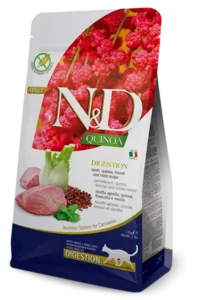N&D Quinoa
Urinary Duck
Adult
Urinary
Indoor and Outdoor
Click to reveal the score breakdown
Tap to view ingredients, guaranteed analysis and more
Ingredients
Boneless duck
20%
Dehydrated duck
20%
Pea starch
Chicken fat
Quinoa seed
8%
Dried whole eggs
Dehydrated herring
Herring oil
Dried cranberry
3%
Chamomile
3%
and also:
Fructooligosaccharide, Yeast extract, Psyllium seed husk, Calcium carbonate, Potassium chloride, Brewers dried yeast,, Salt, Vitamin A supplement, Vitamin D3 supplement,, Vitamin E supplement, Ascorbic acid, Niacin, Calcium pantothenate, Riboflavin, Pyridoxine hydrochloride, Thiamine mononitrate, Biotin, Folic acid, Vitamin B12 supplement, Choline chloride, Beta-carotene, Zinc methionine hydroxy analogue chelate, Manganese methionine hydroxy analogue chelate, Ferrous glycine, Copper methionine hydroxy analogue chelate, DL-Methionine, Taurine, Aloe vera gel concentrate, Green tea extract, Rosemary extract, Mixed tocopherols (a preservative)
Vitamins and Additives
Vitamin A 18000 IU
Vitamin B1 10 mg
Vitamin B2 0.1 mg
Vitamin B6 8.1 mg
Vitamin B12 0.1 mg
Vitamin C 300 mg
Vitamin D3 1200 IU
Vitamin E 600 mg
and also:
Vitamin H (1.5mg), Niacin (150mg), Pantotenic Acid (50mg), Folic Acid (1.5mg), Choline Chloride (2500mg), Beta-Carotene (1.5mg), Zinc chelate of the analogous methionine hydroxylase (910mg), Manganese chelate of the analogous methionine hydroxylase (380mg), Ferrous chelate of glycine hydrate (250mg), Copper chelate of the analogous methionine hydroxylase (88mg), Selenised yeast inactivated (0.4mg), DL-methionine (3500mg), Taurine (2000mg), L-lysine HCl (1000mg), Organoleptic additives: aloe vera extract (1000mg), Green tea extract (100mg), Rosemary extract. Antioxidants: tocopherol-rich extracts of natural origin.
Guaranteed Analysis
Crude Protein
33%
Crude Fat
16.5%
Crude Fiber
2.1%
Moisture
8%
Crude Ash
7.9%
Calcium
1%
Phosphorus
0.9%
Potassium
0.7%
Magnesium
0.08%
Omega 3
0.4%
Omega 6
3.2%
Metabolizable Energy
3984 kcal/kg
Product last updated: April 10, 2024, 6:27 AM
Please hold on while we’re getting the best offers for you
7081



